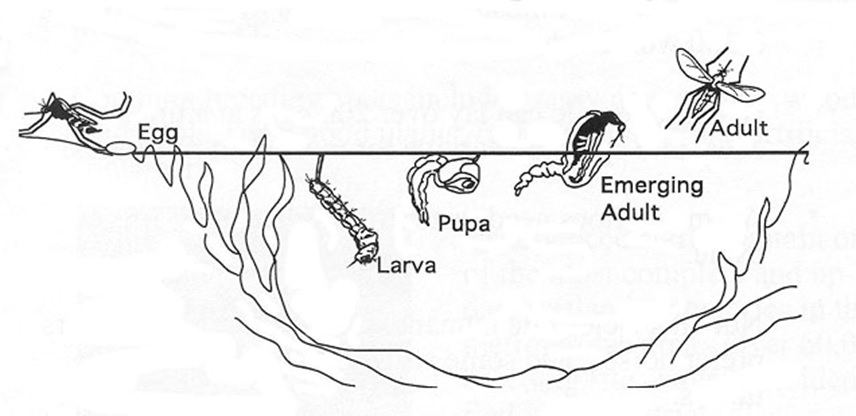The Mosquito Life Cycle

EGGS: Once a female mosquito has received a bloodmeal, she will lay anywhere from 100-300 eggs. Certain species of mosquitoes lay their eggs directly in standing water while others deposit their eggs on damp ground surrounding a wetland that will flood after it rains. Usually eggs will hatch within 48 hours of coming into contact with water.
LARVA: Mosquito larvae have narrow, segmented bodies with a larger portion on one end. They live in water and feed on microorganisms like bacteria and algae. Larvae have a thin siphon on one end that allows them to breathe, which also usually requires they live near the surface of the water. Larvae shed their skin four times, becoming larger after each molt - each phase is called an instar. After the 4th instar, the larvae sheds their skin and emerges as a pupa.
PUPA: At the pupa stage, a mosquito no longer feeds and spends 24-48 hours developing into an adult mosquito. Pupa float near the surface of the water and use two "trumpets" to breathe. When ready, pupa will shed the skin and emerge out of the water as an adult mosquito.
ADULT: Adult mosquitoes will float on the surface of the water for a short time to allow itself to dry and its exterior to harden. Once it is ready to fly, male mosquitoes will seek out nectar from flowers to feed on while female mosquitoes search for a bloodmeal in order to produce eggs. Different species of mosquitoes have different preferences for protein sources - birds, frogs, small mammals, and humans are all preferred by different mosquito species. Most mosquitoes stay within a short distance from where they hatched, but some species can travel miles away from their source.
Mosquitoes of Minnesota
There are over 3,000 species of mosquitoes worldwide and here in Minnesota we have about 51 different species that are established. Only about half of those local species are considered a nuisance meaning that they bite humans or can vector diseases. Some species feed on birds, small mammals, frogs, and even worms or slugs and mostly leave humans alone. However, the most abundant species are human-biting and it's important to know the types of mosquitoes we have in Minnesota and the diseases they can potentially carry.

Culex pipiens mosquito
Culex mosquitoes
Culex is the genus of mosquitoes in Minnesota that are most likely to carry pathogens that lead to West Nile virus, the most common mosquito-borne disease in our state. Some of the common species found in the District include Culex restuans, Culex pipiens, and Culex tarsalis. Culex species lay their eggs directly on standing water in rafts; their larvae commonly found in containers, waste tires, and catch basins. In addition to West Nile virus this genus is capable of carrying Western Equine encephalitis and St. Louis encephalitis, which are not very common in our part of the country.
Aedes vexans or "Summer floodwater mosquito"
The Aedes vexans mosquito is the most common species found throughout the majority of the summer in Minnesota. This species known as the "summer floodwater mosquito" lays its eggs individually on moist soil on the edges of ponds, swamps, and other wetland habitats. Rainfall washes the eggs into the water where the larvae hatches and remains in the water for 5-7 days before becoming a pupa and then emerging as an adult mosquito. This species can fly further than 20 miles from the hatch site, so they are much easier to control when they are in larvae. Aedes vexans are annoying (vexan comes from the Latin vexāre which means "to harass or annoy") but they don't carry diseases that impact humans. They can carry the parasitic worm that causes dog heartworm.
Coquillettidia perturbans or "cattail mosquito"
The "cattail mosquito" gets its name because of a unique trait that makes it the only mosquito of its kind in our state. Unlike the floodwater or container-breeding species who remain as larvae for a few days before emerging from the water, cattail mosquitoes spend all winter as larvae attached to the root of cattails and other vegetation to breathe. They float to the surface in the spring and emerge in one single brood each summer, usually around the beginning of July. Cattail mosquitoes are often the most common mosquito found around the 4th of July, but their numbers decline quickly in the weeks that follow. This species is not the primary vector of diseases in our area, but they have been found to be a bridge vector of Eastern equine encephalitis in other parts of the country.
Learn how MMCD does surveillance and treatment of cattail mosquitoes.
Aedes triseriatus or "Tree hole Mosquito"
Ochlerotatus triseriatus or Aedes triseriatus is more commonly known as the tree hole mosquito because that's the type of habitat where its larvae is commonly found. This species lays its eggs in the type of dark, warm, murky water that can be found in tree holes, waste tires, and other natural containers. The tree hole mosquito is a known vector of La Crosse encephalitis which is a disease that can be harmful to children, which is why it's especially important to remove habitat where this species can reproduce.
Check out our Resident's Guide for advice on how to remove mosquito habitat.



